Ricoh GR Digital II Review
Review Date: April 30th 2008
Author: Mark Goldstein
Leave a comment about this Review
|
Introduction

The Ricoh GR Digital II is the second compact digital camera that we've reviewed recently which has a 28mm fixed focal length lens, putting it it direct competition with the Sigma DP1. The lens on the GR Digital II is a stop faster, offering a maximum aperture of f/2.4, but unlike the DP1 which uses a large APS-C sized sensor, Ricoh's camera is based upon a much smaller 1/1.75-inch CCD sensor with 10 megapixels. Improvements from the original GR Digital model include the new GR ENGINE II image processing engine which promises better noise performance, a neat electronic level function that indicates if the camera is level, and a retro 1:1 aspect ratio for square format photos. Images can be recorded either as JPEGs or in the Adobe DNG RAW format, there's a pop-up flash and an external hotshoe which can accept a flashgun or the optional electronic viewfinder, and full creative control over exposure is available. Ricoh have been focusing all of their recent efforts on making digicams for the professional photographer, releasing some of the genuinely more interesting compacts currently available, so does the Ricoh GR Digital II meet their needs?
Compare Prices
Support PhotographyBLOG: Buy the Ricoh GR Digital II from one of our affiliate retailers:Ease of Use
The Ricoh GR Digital II is a wide and fairly slim compact digital camera that just about fits into the palm of my average sized hands, measuring 107 mm (W) x 58.0 mm (H) x 25.0 mm (D) and weighing around 170g without the battery or memory card fitted. Utilising an aluminium alloy body, it's exceedingly well built - the GR Digital II is one of the most well-constructed Ricoh that I've seen, certainly on a par with the GX100 model, and it's also up there with the best that the other manufacturers have to offer. It has an under-stated, all-black appearance which lends the camera a professional feel. Despite its small dimensions, the Ricoh GR Digital II has a large rubberized handgrip that allows you to get a good grip, and there's a small area of the same material acting as a thumb rest on the rear of the body. The all-metal, central tripod mount is the final giveaway sign that this is intended to be a serious camera (most compacts have a plastic mount squeezed into one of the corners).
The GR Digital II features a 28mm, f2.4 wide-angle optical lens, which will immediately put a lot of people off this camera. Take a look at the Ricoh GX100 if that applies to you, as that camera has a very interesting 24-72mm zoom lens. 28mm is perfect for wide-angle shots, so if you're a fan of land and city scapes, or you're happy to get up close and personal, the combination of the GR Digital II's lens and every photographer's constant companion, their legs, proves to be more versatile than you might first think. Still, street and landscape photographers will love the true wide-angle setting, especially when they discover that Ricoh also offer the optional GW-1 wide conversion lens which provides an even wider 21mm focal length!
The GR Digital II features a new 10 megapixel sensor which provides an extra 2 megapixels in comparison with the original GR Digital. Perhaps more important than the megapixel count are the image types that are on offer. There's the usual choice of Fine and Normal JPEGs, but Ricoh have stolen a march on their competition by providing a RAW mode setting, joining a handful of compact cameras like the Canon Powershot G9, Panasonic DMC-LX2 and Sigma DP1. Even better, the RAW format that they have chosen it not a proprietary one, but Adobe's DNG format, which means that the Ricoh GR Digital II's files are instantly available in any RAW software that supports DNG (virtually every one). This is an excellent move by Ricoh.
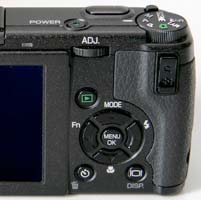 |
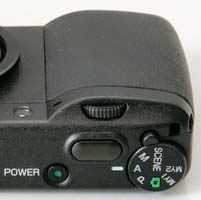 |
| Rear Controls | Top Controls |
There are three external controls which form the creative heart of the GR Digital II. Located on the top right of the camera are the Mode dial and what Ricoh refer to as the Up-down dial, and on the back is the Adj. button. These controls allow you to choose which shooting mode you want to use, with a choice of full auto, program shift, aperture-priority and fully manual, and to control the settings of the particular mode that you have picked. For example, in Manual mode, the Up-down dial sets the aperture and the Adj. button sets the shutter speed, providing quick and intuitive access. Furthermore, pressing he Adj. button allows you to quickly adjust 3 different settings that are commonly used - Exposure Compensation, White Balance and ISO Speed. Even better, the Adj. menu is fully customisable - you can add another setting to it and also choose what all four settings do, allowing you to control exactly what you want quick access to.
Continuing the customisation theme, you can configure the GR Digital II and save the current settings as one of two My Settings modes, which are accessible by setting the Mode dial to either the MY1 or MY2 option. This allows you to configure the GR Digital II for different uses and allows quick access to each configuration (the camera remembers the settings when it's turned off). The Function (Fn) button on the rear of the camera can also be customised. By default it toggles between auto and manual focus, but it can be changed to control one of 16 other settings. Finally, the GR Digital II uses an up/down rocker switch on the back of the camera for operating the digital zoom (and image magnification during playback), but this too can changed to control either exposure compensation or white balance. The GR Digital II is one of the most customisable compact cameras that we've ever reviewed.
As the Ricoh GR Digital II offers a full range of advanced exposure controls, it's quite complex in terms of its design. There are 17 external controls in total, leaving just enough room for the 2.7 inch wide-angle LCD screen on the back of the camera. The GR Digital II dispenses with the design of previous Ricoh cameras, which traditionally have a vertical row of buttons on the rear to the right of the LCD. Instead the GR Digital II offers a slightly more spread out arrangement of the controls. Further appealing to the avid photographer in you, the Ricoh GR Digital II has a range of focusing and metering modes that should cover most situations. On the focusing side, the multi AF system has 9 separate auto focus points, and there's also Spot AF, Manual focus, Snap mode (focuses at 2.5 meters and Infinity. In terms of metering, the multi metering mode is 256 segment, and there's also center weighted average metering and spot metering.
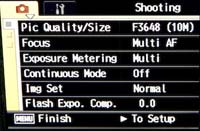 |
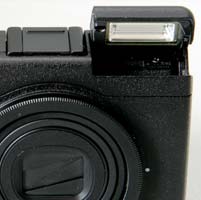 |
| Main Menu | Pop-up Flash |
The visibility, refresh rate and pixel count of the 230,000 pixel, 2.7 inch LCD screen are very good. If you don't like composing your photos by holding the camera at arms length and looking at the LCD screen, there's also another way of framing your shots. You can additionally buy an optional, completely removable optical viewfinder, which is smaller than the one supplied with the original GR Digital. Sold as part of the GR Digital II VF Kit, the OVF slots into the hot-shoe on top of the camera, allowing you to hold the camera up to your eye and instantly giving the GR Digital II the feel of a single-lens reflex camera. Unfortunately Ricoh UK didn't include this with the review sample that they sent us, so I can't comment on its usability.
The electronic leveler is a brand new addition to the GR Digital II. This helps to ensure level shots while viewing through the LCD monitor, both in landscape and portrait mode. You can view the horizontal indicator on the LCD monitor to ensure that shots are aligned horizontally. If you're using the external viewfinder, or can't see the LCD screen in very bright sunlight, then the camera can also be set to make a sound to indicate a level horizon. It doesn't sound like a big deal in theory, but in practice it really helps to make all those wide-angle shots perfectly level. The Depth of field indicator is an equally useful function. If you set the GR Digital II to either Manual or Aperture priority mode, and the Focus mode to Snap, Manual or Infinity, a vertical scale on the left of the LCD screen indicates the depth-of-field at the current aperture, helping to ensure sharp focus when you're not relying on the camera's auto-focus system.
If you have never used a digital camera before, or you're upgrading from a more basic model, reading the comprehensive and easy-to-follow 200+ page manual before you start is a must. Thankfully Ricoh have chosen to supply it in printed format, rather than as a PDF on a CD, so you can also carry it with you for easy reference in the field. The main menu system on the Ricoh GR Digital II is straight-forward to use and is accessed by pressing the Menu button in the middle of the navigation pad. There are two main menus, Shooting and Setup. Quite a lot of the camera's main options, such as image size, sharpness, metering mode and continuous mode, are accessed here, so the Shooting Settings menu has 12 options spread over 2 screens, and the Setup menu has 31 options. Due to the large LCD screen and restricting the number of on-screen choices to 6, the various options and icons are clear and legible.
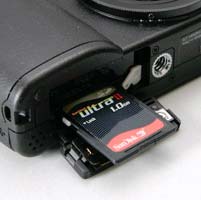 |
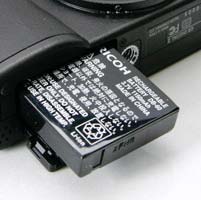 |
| Memory Card Slot | Battery Compartment |
Ricoh are well known for delivering responsive cameras, and the GR Digital II certainly continues in that tradition. The start-up time from turning the Ricoh GR Digital II on to being ready to take a photo is responsive at around 1 second. Focusing is very quick in good light and the camera happily achieves focus most of the time indoors or in low-light situations. It takes about 0.5 second to store a JPEG image, allowing you to keep shooting as they are being recorded onto the memory card, and there is virtually no LCD blackout between each image. Shooting in RAW mode slows things down considerably, with the GR Digital II taking around 4 seconds to store a RAW image, although you can take another shot while it's being written to memory (but only for 2 shots). In the fastest Continuous mode the camera takes 2 frames per second for an unlimited number of images at the highest JPEG image quality, which is very good for this class of camera. Unfortunately there is no Continuous option when shooting in RAW mode. Overall the Ricoh GR Digital II is very quick in terms of operational speed when shooting JPEGs, and just about acceptable for RAW files.
Once you have captured a photo, the Ricoh GR Digital II has a fairly average range of options when it comes to playing, reviewing and managing your images. You can scroll through the images that you have taken, view thumbnails, zoom in and out up to 16x magnification, view slideshows, set the print order, delete, protect and resize an image. The Display button toggles detailed settings information about each picture on and off, such as the ISO rating and aperture / shutter speed, and there is a small histogram available during both shooting and playback. The White Saturation display mode during image playback indicates over-exposed highlights by flashing those areas on and off. When taking a photo, pressing the Display button toggles between the detailed information, the histogram and gridlines to aid composition.
In summary the Ricoh GR Digital II is a very intuitive and almost infinitely customisable pocket camera for the discerning photographer - if only all cameras had this much care and attention lavished on them.
|
![]() PhotographyBLOG
is a member of the DIWA
organisation. Our test results for the Ricoh GR Digital II have been submitted to DIWA
for comparison with test results for different samples of
the same camera model supplied by other DIWA
member sites.
PhotographyBLOG
is a member of the DIWA
organisation. Our test results for the Ricoh GR Digital II have been submitted to DIWA
for comparison with test results for different samples of
the same camera model supplied by other DIWA
member sites.
